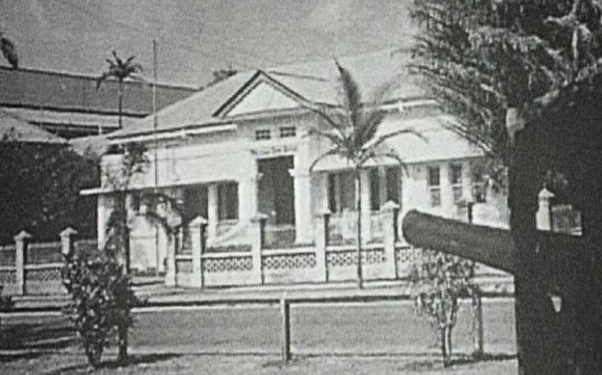AHS projects with Cairns Regional Council include a CMP for Mulgrave Shire Council Chambers
AHS has a well-established relationship with Cairns Regional Council (CRC), delivering a broad range of heritage reports relating to the restoration and adaptive re-use of State heritage listed buildings within the proposed Cairns Gallery Precinct.
One of these sites is the former Mulgrave Shire Council Building adjacent to Cairns Court House (read more about our work here and here) and close to Cairns Art Gallery.
CRC commissioned the AHS team to prepare a Conservation Management Plan (CMP) for the Mulgrave Shire Council Building. The purpose of this CMP was to provide a greater understanding of its State-level significance so that the site’s heritage values could be protected and managed during any future redevelopment.
Funded by sale of the Cairns-Mulgrave Tramway
Local government arrived in the Cairns region in 1879 through the Cairns Divisional Board. Soon afterwards Cairns Municipal Council was established to administer the town itself, becoming Cairns City Council in around 1905.
In 1897 the Cairns Divisional Board was the first Australian local authority to own, construct and operate a railway system. The Cairns-Mulgrave Tramway, which carried agricultural products and passengers, was subsequently purchased by the Queensland Government in 1911.
Profits from this sale enabled construction of the Cairns Shire Office in 1912. It was renamed Mulgrave Shire Council Chambers upon the establishment of Mulgrave Shire Council in 1940.
The building was designed by the architectural partnership of Charles Lynch and Walter Hunt, who were based in Townsville and Cairns and worked across northern Queensland between 1911 and 1921.
Mulgrave Shire Council Chambers is the earliest surviving shire council building in Cairns and provides an important illustration of the growth of Cairns and the former Cairns Shire in the years before the First World War.
The Cairns Shire Council Offices circa 1912, Cairns Historical Society.
A fine example of early twentieth century council chambers
The former Mulgrave Shire Council Chambers is a single storey, rendered masonry ‘t-shaped’ building with a hipped corrugated iron roof. The symmetrical northeast elevation has a gabled central entry with verandahs on either side.
The roof has battened soffits with paired timber brackets. Multi-paned clerestory windows are located below the eaves and above the verandah roof.
The projecting gabled front entrance is supported by rendered corner columns and has the name MULGRAVE SHIRE OFFICE in relief on the lintel above the entry. The entrance is accessed by steps with curved rendered masonry balustrades.
External elements that retain a high level of heritage significance include the rendered masonry frontage, gabled portico, front door and architrave, cast iron balustrades and the front entrance stairs.
The internal space was originally partitioned into front offices, a reception area and the meeting room. Although some of these have been modified, the original design features generally remain and the building’s layout is clearly interpretable.
Original verandah facing north
Potential for future interpretation
Mulgrave Shire Council Chambers is a fine example of early twentieth century council chambers that have been adapted to suit Queensland’s tropical climate. The stylised circular motif and relief detailing of the facade express a high quality of design and workmanship.
The AHS team concluded that the building has a Moderate-to-High level of heritage integrity, with the internal layout and external design largely remaining intact since its original construction.
Although minimal moveable heritage items survive from the building’s original use, there is potential for future interpretation of various aspects of its importance as an administration centre for Cairns.
Contact us
To discover how we may be able to assist on your next project, contact us today here or phone (07) 3221 0000. You can also connect with us on LinkedIn.
Mulgrave Shire Council Chambers facade
You might also like to read:
The Challenge
Local government arrived in the Cairns region in 1879 through the Cairns Divisional Board. Soon afterwards Cairns Municipal Council was established to administer the town itself, becoming Cairns City Council in around 1905.
In 1897 the Cairns Divisional Board was the first Australian local authority to own, construct and operate a railway system. The Cairns-Mulgrave Tramway, which carried agricultural products and passengers, was subsequently purchased by the Queensland Government in 1911.
Profits from this sale enabled construction of the Cairns Shire Office in 1912. It was renamed Mulgrave Shire Council Chambers upon the establishment of Mulgrave Shire Council in 1940.
The building was designed by the architectural partnership of Charles Lynch and Walter Hunt, who were based in Townsville and Cairns and worked across northern Queensland between 1911 and 1921.
Mulgrave Shire Council Chambers is the earliest surviving shire council building in Cairns and provides an important illustration of the growth of Cairns and the former Cairns Shire in the years before the First World War.
How we helped
The former Mulgrave Shire Council Chambers is a single storey, rendered masonry ‘t-shaped’ building with a hipped corrugated iron roof. The symmetrical northeast elevation has a gabled central entry with verandahs on either side.
The roof has battened soffits with paired timber brackets. Multi-paned clerestory windows are located below the eaves and above the verandah roof.
The projecting gabled front entrance is supported by rendered corner columns and has the name MULGRAVE SHIRE OFFICE in relief on the lintel above the entry. The entrance is accessed by steps with curved rendered masonry balustrades.
External elements that retain a high level of heritage significance include the rendered masonry frontage, gabled portico, front door and architrave, cast iron balustrades and the front entrance stairs.
The internal space was originally partitioned into front offices, a reception area and the meeting room. Although some of these have been modified, the original design features generally remain and the building’s layout is clearly interpretable.
Results
Mulgrave Shire Council Chambers is a fine example of early twentieth century council chambers that have been adapted to suit Queensland’s tropical climate. The stylised circular motif and relief detailing of the facade express a high quality of design and workmanship.
The AHS team concluded that the building has a Moderate-to-High level of heritage integrity, with the internal layout and external design largely remaining intact since its original construction.
Although minimal moveable heritage items survive from the building’s original use, there is potential for future interpretation of various aspects of its importance as an administration centre for Cairns.
Contact us
To discover how we may be able to assist on your next project, contact us today here or phone (07) 3221 0000. You can also connect with us on LinkedIn.
You might also like to read:




